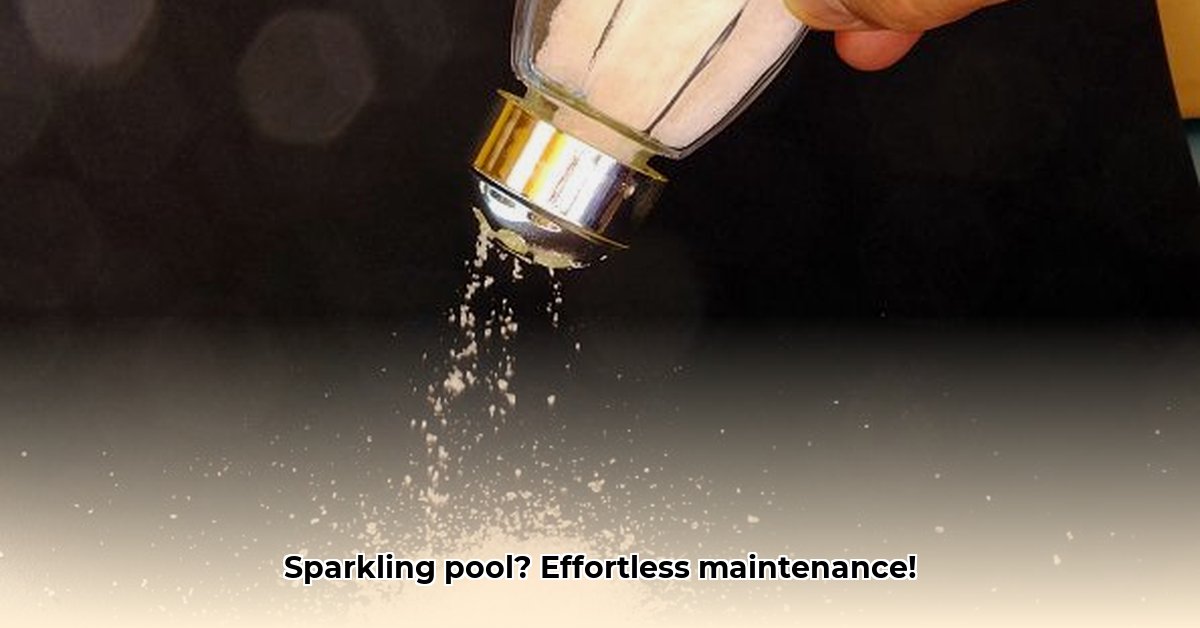Want a sparkling saltwater pool without the hassle? This guide shows you how! We’ll cover everything from quick daily checks to the occasional deep clean, helping you keep your pool crystal clear with minimal effort. Learn about water chemistry, troubleshooting problems, and the simple steps to keep your pool looking amazing year after year. Let’s dive in and make pool maintenance easy!
Saltwater Pool Care: Ensuring Sparkling Water and Longevity
Keeping your saltwater pool sparkling and inviting doesn’t have to be a chore. With a little consistent effort and the right know-how, you can enjoy crystal-clear water all season long. Think of it like caring for a beloved pet – regular attention pays off handsomely! This guide breaks down the process into simple, manageable steps and helps keep your pool in pristine condition. We’ll focus on daily, weekly, monthly, and seasonal tasks to keep your pool balanced.
Daily Essential Tasks: Maintaining a Pristine Swimming Environment
Your daily pool maintenance is like a quick morning routine – short, sweet, and essential for a healthy pool. Start by skimming the surface, scooping out leaves, bugs, and other debris that have settled overnight. A long-handled skimmer net makes this task quick and efficient. Next, give the pool walls and floor a quick brush with a pool brush. This prevents dirt and grime from sticking, making future cleanings much easier. Finally, cast a glance at your pump and filter; ensure they’re humming along and not clogged with anything. Listen for unusual noises that could indicate a problem. These simple steps, performed consistently, make a huge difference. Consider using an automatic pool cleaner to minimize manual skimming and brushing.
Weekly Water Analysis: Achieving Chemical Equilibrium for Superior Clarity
Each week, it’s time for a chemical checkup – your pool’s equivalent of a doctor’s appointment. You’ll need a reliable test kit to measure key things: pH, alkalinity, salinity, calcium hardness, and sanitizer levels (ideally free chlorine, but could be another sanitizer depending on your setup). Saltwater pools typically need a salt level between 2700-3400 ppm. Just like our bodies need a balanced internal environment, your pool water needs the right chemical balance. Testing helps you identify any imbalances. If levels are off, adjust them using chemicals according to the product instructions – always adding the chemicals slowly and following safety precautions. Think of this as creating the perfect recipe for your pool water—precise measurements are key. Always test your water before adding any chemicals to avoid over-correction. Different test kits use different methods, so always follow the instructions for the kit you have.
Here’s a sample weekly checklist to keep you on track:
| Day | Task |
|---|---|
| Sunday | Skim, brush, check pump, and filter. |
| Monday | Test and adjust water chemistry (pH, alkalinity, salinity, calcium hardness, sanitizer). |
| Tuesday | Skim and brush. |
| Wednesday | Check pump and filter. |
| Thursday | Test and adjust water chemistry (if needed). |
| Friday | Skim and brush. |
| Saturday | Relax and enjoy your beautiful, clean pool! |
Monthly Inspection Checklist: Maximizing System Performance and Water Quality
Once a month, dedicate a little more time to a more thorough check-up. Pay close attention to your salt cell – the heart of your saltwater system. Inspect it for any buildup of calcium or other minerals. Carefully clean it according to the manufacturer’s instructions – a gentle approach is usually best. A diluted muriatic acid solution can be used for cleaning, but always follow safety precautions. While you’re at it, make sure to visually check your pump and filter for any signs of wear and tear or leaks. Replace any worn parts immediately to prevent further damage. If you have a filter that needs backwashing, do so. The frequency of backwashing depends on your filter type and how often you use the pool, but a monthly check is a good habit to develop. A clean filter ensures efficient operation and prevents those annoying clogs. Also, check the area around your pool for high salt concentrations from splashing; rinse these areas to prevent erosion.
Seasonal Pool Maintenance: Adapting to the Changing Climate
Your pool maintenance routine will shift with the seasons. In autumn, prepare your pool for winter. This usually involves lowering the water level to prevent damage from freezing, draining all equipment, and covering the pool. Add winterizing chemicals to protect the equipment and prevent algae growth. In the spring, thoroughly clean your pool, remove the cover, and refill the water. Balance the water chemistry before starting up the system. Summer calls for more frequent skimming and brushing because of increased use. Adjust filtration times and chemical testing frequency according to bather load. Following the seasons’ rhythm keeps your pool in great shape year-round.
Deep Filter Cleaning and Professional Assessments For Long-Term Investment
Once a year, it’s a good idea to have a pool professional do a full inspection and deep clean your filter. Cartridge filters should be thoroughly cleaned or replaced, sand filters should be deep cleaned, and diatomaceous earth (DE) filters should be disassembled and cleaned. Think of it as a comprehensive annual checkup for your pool. A trained professional can spot potential problems you might miss and offer tips for preventing future issues. During this visit, you should also consider replacing your salt cell. These cells generally last 3-5 years, but their lifespan can vary depending on several factors (see the table below). Salt cell replacement typically costs between $300 and $800, depending on size and model. While it might seem expensive, it’s a worthwhile investment that guarantees optimal performance and longevity of your pool.
Saltwater Pool Challenges: Proactive Measures And Troubleshooting Tips
Even with regular care, some minor issues may pop up. Understanding these common problems and their likely causes is key to tackling them quickly. For instance, high pH could indicate a need for pH reducer (such as muriatic acid or sodium bisulfate), while cloudy water might suggest insufficient filtration, an imbalance of chemicals, or high calcium hardness. Scaling (mineral build-up) can be addressed with specific cleaning products designed for salt cells. A malfunctioning salt cell will need professional assessment and likely replacement. Addressing these promptly ensures your pool stays in top shape. Algae blooms are also common and require shocking the pool and balancing the water chemistry.
Understanding Salt Cell Longevity: Key Contributing Variables
Understanding what impacts your salt cell’s lifespan helps you plan for replacement and potential maintenance.
| Factor | Impact on Lifespan |
|---|---|
| Water Quality | Poor water quality (high levels of contaminants) significantly shortens lifespan |
| Cleaning Frequency | Regular, thorough cleaning extends lifespan considerably |
| Water Usage | Heavy use tends to shorten lifespan, due to increased wear and tear. |
| Manufacturer & Model | Lifespans vary significantly across different brands and models. Higher-quality cells often last longer. |
| Proper Installation | Incorrect initial setup can significantly reduce lifespan. |
| Stabilizer (Cyanuric Acid) Level | Incorrect stabilizer levels will reduce chlorine production efficiency and shorten cell life. |
Remember, consistent care is key to enjoying your saltwater pool for years to come. A little proactive maintenance keeps your pool sparkling and saves you from more costly repairs down the line.
Preventing Calcium Scaling: Essential Strategies for Saltwater Pool Salt Cells
Key Takeaways:
- Maintaining proper water chemistry is crucial for preventing calcium scale. This includes regular testing and adjustments of pH, alkalinity, calcium hardness, and salt levels.
- Regular cleaning of your salt cell is essential. A clean cell operates more efficiently and lasts longer. Inspect the cell every three months.
- Using a scale inhibitor can help minimize calcium deposits. Phosphate removers can also help keep calcium from forming scale.
- Understanding your water source’s hardness can provide context for preventative actions. Hard water necessitates more frequent maintenance.
Water Chemistry Balance: Setting the Stage for a Sparkling Pool
Daily tasks are the foundation of a healthy pool. Skim the surface, removing leaves and debris. Brush the walls and floor to dislodge clinging dirt. Check your pump and filter to ensure they’re running smoothly. These small steps prevent larger problems from brewing. Aim for a pH between 7.2 and 7.8, alkalinity between 80 and 120 ppm, calcium hardness between 200 and 400 ppm, and a salt level recommended by your salt chlorinator manufacturer (usually 2700-3400 ppm).
Water Testing Methods: The Heart of Pool Maintenance
Weekly is when you dive into water chemistry. Test your pH, alkalinity, salinity, calcium hardness, and chlorine levels. Maintaining balance is key. A simple test kit makes this easy. Use either a liquid test kit or test strips, but ensure the test strips are fresh for accurate readings. Are your levels within the recommended ranges? Adjust them as needed using pool chemicals. A slightly unbalanced pool is easier to manage than a severely out-of-whack one. Always add chemicals slowly and allow them to circulate for several hours before retesting.
Preventative Measures: Efficiency and Longevity
Once a month, give your salt cell some attention. Inspect it for any buildup. A gentle brushing can prevent scaling. For more stubborn deposits, periodic cleaning is key. How to prevent calcium buildup in saltwater pool salt cells often comes down to these routine cleanings. Think of it as a monthly tune-up for your pool’s
- Glass Tile Shower Ideas to Create a Stunning Bathroom Space - December 7, 2025
- Glass Wall Tile Ideas for Kitchens and Bathrooms - December 6, 2025
- Glass Tile Bathroom: Create a Beautiful, Easy-Clean Space - December 5, 2025










